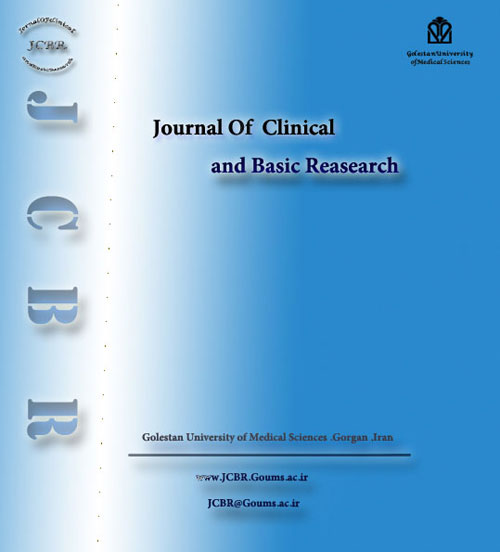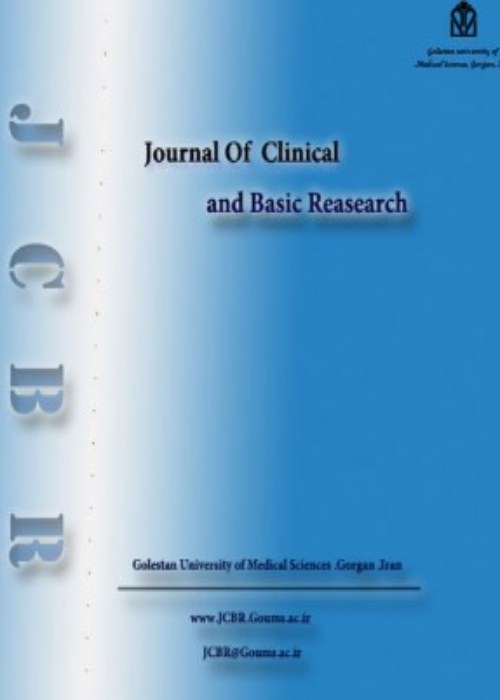فهرست مطالب

Journal of Clinical and Basic Research
Volume:2 Issue: 3, Summer 2018
- تاریخ انتشار: 1397/08/11
- تعداد عناوین: 6
-
Pages 1-9Background and objectivesFree (open) access to scientific information has emerged as a new paradigm to resolve existing problems and to improve the scientific communication process. This study was conducted to evaluate the level of familiarity with the open access movement among faculty members of Golestan University of Medical Sciences, Iran.methodsA pre-made questionnaire was utilized in this analytical survey. Cronbach's α of 0.75 verified the reliability of the questionnaire. The study included 157 faculty members employed via non-probability randomized sampling and the Cochran's sample size formula. Descriptive statistics, Kolmogorov-Smirnov test, Tukey’s test and Pearson correlation were used to analyze the data.ResultsFaculty members had little acquaintance with the open access to scientific information. The greatest level of familiarity was with ‘‘open access journals’’ (mean score: 2.42), while the lowest level of familiarity was with ‘‘the open access movement’’ (mean score: 3.07).ConclusionsThe faculty members of the Golestan University of Medical Sciences have relatively moderate level of familiarity (compared to other universities in the country) with the open access movement, but it is still far from ideal. Given the importance of free access to scientific information and its positive impact on the visibility and credibility of scientific products, it is essential to plan and take action to raise awareness and promote implementation of this movement among faculty members.Keywords: Open access movement, Faculty members, Golestan University of Medical Sciences
-
Pages 10-18Background and objectivesDue to the negative effects and risks of general anesthesia for the mother and fetus, spinal anesthesia has been the preferred method of anesthesia for cesarean section. Nevertheless, this method has its own disadvantages and side effects, which must be prevented or treated through effective approaches. This study evaluates the effect of wearing compression socks on degree of hypotension and ephedrine administration after spinal anesthesia in candidates for cesarean section.methodsIn this clinical trial, 80 candidates for cesarean section were equally divided into an intervention group and a control group. Immediately after spinal anesthesia, the patients were worn compression socks from the tip of the toe fingers up to the knees. Blood pressure was measured and recorded just before spinal anesthesia and every 5 minutes after, for 30 minutes. The recorded data were analyzed by SPSS (version 19).ResultsThe mean blood pressure recorded 5 minutes and 15 minutes after spinal anesthesia differed significantly between the two groups (P<0.05). Moreover, ephedrine was not administered for the patients in the intervention group in the first 5 minutes after spinal anesthesia.ConclusionsConsidering the positive effects of wearing compression socks on the anesthesia-induced hypotension and amount of ephedrine administration, this non-invasive method is highly recommended for cesarean section candidates who undergo spinal anesthesia.Keywords: cesarean section, spinal anesthesia, hypotension
-
Pages 19-24BackgroundProteus syndrome is a rare genetic disorder characterized by overgrowth of bones, skin, and other tissues, with vascular malformations, epidermal moles, and subcutaneous masses. We herein present a case of Proteus syndrome with extensive hemangiomas. Case description: An 11-year-old girl with Proteus syndrome was presented with extensive hemangioma, asymmetrical growth in lower limbs, skin and bone lesions, and facial hemihypertrophy.ConclusionsGiven the severe complications of this syndrome and the risk of early death in the patients, early diagnosis is essential for reducing the risk of morbidity and mortality. These patients should be followed up for progressive skeletal deformities, hemangiomas, and malignant or benign tumors. In our case, risk of thrombosis and pulmonary embolism limited surgical intervention.Keywords: Proteus Syndrome, Hemangioma, Facial hemihypertrophy
-
Pages 25-32Background and objectivesParenting style is a determinative and important factor in psychopathology and child development. The quality of parent-child relationship has a significant impact on self-efficacy, happiness and resilience of individuals. The objective of this study was to investigate the relationship between parenting style and self-efficacy and resilience of gifted and normal male students in Sari, Iran.methodsThis descriptive correlational study was performed on 120 gifted students and 120 ordinary male high school students of Sari in 2017. Data were collected using the Baumrind’s parenting style questionnaire, Connor-Davidson resilience scale and Sherer's general self-efficacy scale. The data were analyzed by SPSS-16 using descriptive and inferential statistics (Pearson correlation coefficient and t-test).ResultsAuthoritative parenting style had a significant and positive correlation with students’ resilience (P = 0.0001) and self-efficacy (P = 0.0005). There was a significant and negative correlation between the authoritarian and permissive parenting styles and students’ resilience (P = 0.0001). In addition, the mean scores of parenting styles, self-efficacy and resilience were significantly different between ordinary and gifted students (P<0.0001).ConclusionsThe results of this study indicate the important role of parenting style in the self-efficacy and resilience of students. Therefore, it is recommended to educate parents about positive and constructive parenting styles in order to prevent the consequences of unhealthy parenting styles.Keywords: Parenting style, self-efficacy, resilience, gifted, normal student
-
Pages 33-38Background and objectivesBenzodiazepine poisoning is one of the most important and common medical emergencies worldwide. The purpose of this study was to evaluate the pattern of poisoning with benzodiazepines in Gorgan, Iran.MethodsThis cross-sectional and descriptive-analytical study was conducted on patients with acute benzodiazepine poisoning admitted to 5th Azar Hospital in Gorgan between 2008 and 2014. Data were collected from medical records of patients. Statistical analysis was performed using SPSS software (version 16).ResultsBenzodiazepine poisoning accounted for 37.2% of all drug poisoning cases. Of the 230 cases of benzodiazepine poisoning, 108 (50.7%) were female, and most cases (53.5%) belonged to the 20-29 years age group. Suicide attempt was the predominant (91.1%) type of benzodiazepine poisoning. Among the benzodiazepines, alprazolam (33.3%) and diazepam (30.5%) were the chief causes of drug poisoning. In addition, in 7.5% of the subjects, benzodiazepines were taken in combination with other drugs, especially tramadol (19.2%). Age, marital status, employment status, education level and place of residence were significantly associated with benzodiazepine poisoning (P<0.001).ConclusionsBenzodiazepines, particularly alprazolam and diazepam, are responsible for more than one-third of all drug poisoning incidents in Gorgan. Self-poisoning with this group of drugs as an attempt to commit suicide is most prevalent among young individuals.Keywords: Suicide, Poisoning, Benzodiazepines, Gorgan, Iran
-
Pages 39-44Background and objectivesIdentifying gaps in the quality of services provided by medical centers can be useful for developing healthcare quality improvement plans. The purpose of this study was to assess satisfaction of clients with the quality of services in a maternity ward using the SERVQUAL model.methodsThis descriptive-analytical study was conducted on 175 women hospitalized in the maternity ward of Shahid Sayyad Shirazi Hospital in Gorgan, Iran. Data were collected using a demographic information questionnaire and a standard SERVQUAL questionnaire comprising 22 questions on service quality in five dimensions: tangibles, reliability, responsiveness, assurance, and empathy. The questionnaire was completed at the time of admission and after receiving the services to measure expectations and perceptions, respectively. The data were analyzed with SPSS (version 16) using paired sample t-test.ResultsMost subjects were homemaker (92.35%) and pregnant for the first time (44.12%), and had high school diploma (43.53%). The level of expectations and perceptions in all dimensions was significantly higher than average (P=0.00009). There were significant negative gaps between the subjects’ expectations and perceptions in all dimensions of service quality (P=0.00009).ConclusionsThe negative gap in the dimensions of service quality indicates the high-level expectations of clients in the maternity ward. Based on the clients’ perceptions, their satisfaction was below their expectations after receiving the services, which created a negative gap. The high expectations of clients can be attributed to the raise in awareness of the community towards provision of health services and improvement of the healthcare system. Thus, the quality of the services provided and equipment used in hospitals should be high enough to meet the expectations of clients to a reasonable degree.Keywords: SERVQUAL model, services, customer satisfaction, teaching hospitals, Gorgan


